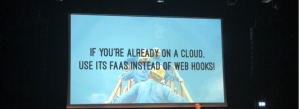
Food For Thought From ServerlessDays Milan

I just returned from ServerlessDays Milan, where I had the pleasure and honor of speaking at a session and running a workshop about Serverless debugging. It was a jam-packed two days in a beautiful city, and a great opportunity to mingle with local serverless enthusiasts as well as some of the leading serverless thought leaders from all over the world.
Serverless is young and interesting technology and a lot of developers are excited about experimenting with it. At the same time, it’s already famous — or perhaps infamous — for the challenges that it presents. With most companies that are interested in serverless just taking their first baby steps with the technology, it’s a great time to listen to early adopters and learn how to make your path to serverless a smooth one.
Less is more
Even companies that already use serverless rarely operate significant serverless-based systems in production. Bustle Publishing Group is an exception, which made CTO Tyler Love’s talk on how they do it particularly interesting and valuable. While chatted with him afterward, I asked him how many functions they use. To my surprise, the answer was 12 — much less than the dozens I was expecting!
The very modest number of functions is partially explained by the fact they use GraphQL to allow a single point to answer many varied and complicated queries. Since I’ve seen a few companies running over 50 functions start to lose control over their own system, this was a refreshing approach and well-worth considering when planning your function complexity.
The train has left the station
Seeing people glued to their seats at the closing session of a full day of lectures can mean only one thing – that the speaker is off-the-charts charismatic. Which is a perfect description for Gojko Adzic. I enjoyed his sense of humor as much as his professional views on how to use external services such as Auth0 and Twilio by extending them rather than orchestrating them.
Adzic claims that webhooks are “messy” (you should listen to his talk to hear more about it!) and are being replaced, albeit slowly, by serverless engines. In fact, this is the foundation of a new way of architecting SaaS software, which serves both platform builders and product builders. For example, companies like Twilio and Netlify are probably already using Lambdas behind the scenes, on their own AWS accounts.
The key takeout of his presentation was that whether you’re a serverless fan or not, you should accept the fact that you will end up building software around it.

The go-to place for serverless apps
Some of you may already be familiar with the AWS Serverless Application Repository. If you’re not, you should be, since it is a really worthwhile place to get started with serverless and I thank Matthieu Napoli for pointing it out to me. I would definitely use it to prepare future workshops but you can use it to publish, discover and deploy serverless applications (based on SAM) and components, both privately within your organization, and publicly.
While it is not yet a fully mature service, it is growing rapidly and promises to quickly grow much more interesting. If you need any sample applications for DevOps, training or any other purpose, it’s the place to go to. Read more about the repository in this blog post and start poking around!
What’s for dessert?
Food in Milan — real food, not just food for thoughts — is incredible. So is the architecture. I’d be thrilled to go to ServerlessDays anywhere, worldwide, but I doubt if I’d find a better culinary and cultural destination. I only wish that I had more time to enjoy it!





